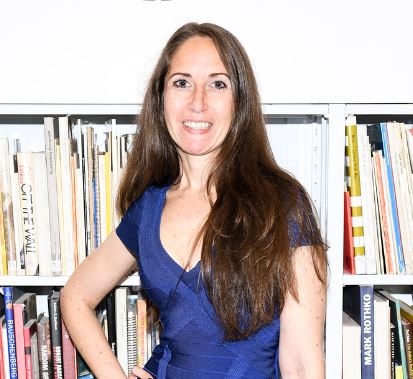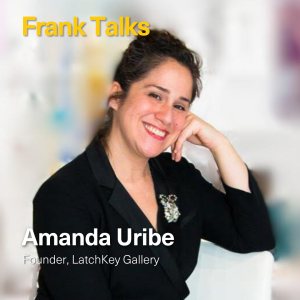Naomi Huth is the Director of Art Collection for NYC Health + Hospitals, Arts in Medicine, curating the largest public art collection in New York City. Naomi works to highlight the concepts of diversity, equity, inclusion, and accessibility in her method of collecting, philanthropy, collaboration, and mentoring emerging artists. She has focused on acquiring works by underrepresented artists to improve and diversify the collection as well as integrating diverse perspectives into the collection and fostering a better understanding of the issues of today through the lens of art.
From 2012-2021, she was the Curator and Director of Collection for the Joseph M. Cohen Family Collection, a large private collection with six locations around the United States. She has previously held curatorial positions at the New Museum, Museum of Arts and Design, Rubin Museum, and the de Young Museum. Naomi is a member of the Young Collectors Council Acquisitions Committee at the Guggenheim, the advisory board of the Center for Photography in Woodstock, Independent Curators International, and is an accredited member of the Appraisers Association of America. She received her M.A. in Museum Studies and Art History from the City College of New York (CCNY) and her B.S. in Fashion Design and Art History from Drexel University.
AF: Hi Naomi! We are so glad to chat with you. To start us off, we want to know more about your upbringing. Where are you from and what are the arts communities like there?
NH: I was born in NYC but my family moved to a very small town in Northern California when I was three. My father is an artist and my mother was a dancer for a number of years so the arts played an integral part in my upbringing. Both of my parents were incredibly involved in teaming up with my elementary and high school teachers to bring art into the classroom. Growing up, my parents taught a variety of workshops at our home including basket weaving, clay throwing, painting, dance, and drumming.
My parents felt that exposure to different cultures and traditions was extremely important and we began traveling internationally when I was 6 months old. Our home was filled with artwork, masks, tapestries, and musical instruments from our family trips and the extended years my parents spent living abroad during the 1970s.
I never felt like my upbringing was “normal” compared to others in my area, but it encouraged me to express myself creatively and was a constant reminder that you can create your own community.
AF: Please tell us a little more about yourself, when did you realize you wanted to pursue a career in this industry?
NH: I came into the Art World later than most of my peers and in a very roundabout manner. I initially tried to stay away from a career in the arts so that I wouldn’t be in the same industry as my father. From a young age, I was focused on math and science and began my undergraduate degree at the University of Pennsylvania pre-med. However, I was very involved with theater throughout high school and continued to work in costume design throughout college. After a couple years at college, spending the majority of my time in theater spaces, I decided to switch to a Fashion Design degree. I worked in fashion for several years, slowly transitioning to trend forecasting. I realized that I loved the design, art, and research elements but the industry wasn’t the right fit for me. I began working at both a museum and a gallery in different capacities and realized that the art world was where I belonged.
AF: What was your first job? What is an important lesson from it that has carried with you?
NH: I began working with my father for his open studios and exhibitions from a very young age, although I never considered that my first job! My first real job in the arts was an internship at the Rubin Museum working on public programs. The most important lesson that I have carried with me is the importance of giving people the responsibility, trust, and freedom to succeed in their role. My boss at the time, Tim McHenry, allowed me to create a nine-week film series for the museum and as a result realize I wanted a career in the arts.
AF: You are the Director of Art Collection for NYC Health + Hospitals, Arts in Medicine. Tell us more about your role where you curate the largest public art collection in New York City!
NH: As the Director of Arts Collection for NYC Health + Hospitals, Arts in Medicine, we are committed to preserving more than 7,000 works of art and making them accessible to the public through exhibitions and programming. My curation seeks to highlights diverse points of view from site-specific commissions to new acquisitions. In addition to curating all of our hospital sites, we are working on additional exhibitions throughout the city which showcase art that reflects an interest in underlying concepts such as innovation and diversity. As a department, we are also growing our exhibition capabilities and supporting many of our significant programs including the Community Mural Project. I am also responsible for coordinating the management of our pieces, including oversight for the digital archive, ongoing restoration efforts, care, security measures and preservation of all works of art in the collection.
AF: When curating artwork for this unique collection, what do you look for?
NH: Honestly, it depends on so many different elements: the physical space, department, neighborhood, patients and clinical staff involved. Our art collection aims to create a calming atmosphere for patients and their families and supportive, healing places for staff. We are currently working to identify holes in our collection and acquire works for our collection which accurately represent the community NYC Health + Hospitals serves.
AF: What are some challenges that you face in this position?
NH: One of the biggest challenges is the logistics of traveling throughout all five boroughs to work with the different teams in charge of each facility and/or department. NYC Health + Hospitals has eleven acute care hospitals, five nursing homes, six diagnostic and treatment centers, more than seventy community-based primary care sites, and our central office buildings.
AF: What are you most excited for this year at your job or in the art world as a whole?
NH: I am excited for continued collaboration with my peers in the art world as well as bringing more awareness to our incredible collection.
AF: As you know, Art Frankly is a community that cares about job transparency and supporting fellow art professionals. What is the best piece of advice you can give about working in the art world?
NH: Never stop asking questions and speaking with your peers.
AF: How do you think the art world can become more transparent?
NH: There is so much of the Art World that happens whispered in the shadows, and the only way to create more transparency around salaries, hiring practices, and other essentials of art world employment is to have difficult conversations out in the open.
AF: Naomi, thank you so much for participating in Frank Talks! To wrap this interview up, we would love to know: If you could own work by 5 different artists/craftspeople, who would be in your collection?
NH: Ali Banisadr, April Bey, Zanele Muholi, Faig Ahmed, and Maria Nepomuceno. This is one of the most difficult questions to answer. It really depends on the day and if it is for my personal collection or our Arts in Medicine collection.




